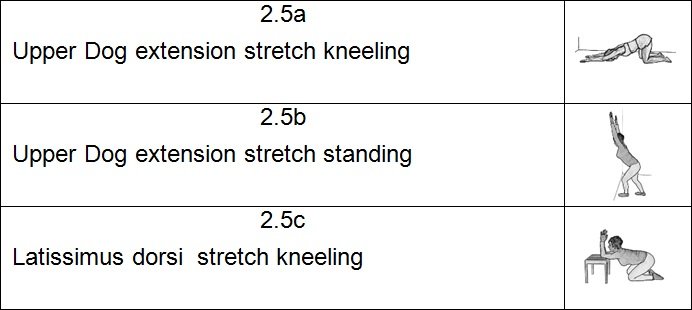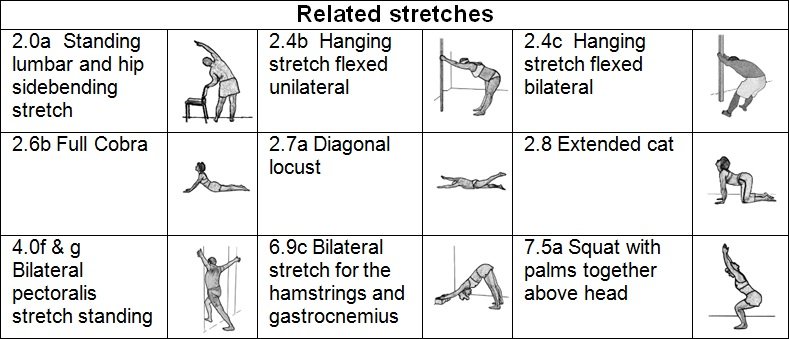2.5 Upper Dog – active extension stretches for the shoulders, thoracic and lumbar spine

2.5a Upper Dog extension stretch kneeling
Starting position
- Kneel on the floor, preferably on a carpet or mat.
- Place your elbows, forearms and hands flat on the floor so they are parallel and shoulder distance apart.
- Place your forehead on the floor and keep your palms down.
- Your hips should be over your knees so that your thighs are vertical.
- Place your knees and feet slightly apart for better balance.

Technique
- Straighten your right elbow but keep your left elbow flexed on the floor.
- Take a deep breath in.
- Exhale and move your right shoulder, thoracic and ribs towards the floor.
- Continue to bring your right side towards the floor with each exhalation.
- Focus on the area in your thoracic spine that is most restricted.
- Sidebend left by sideshifting your upper thoracic spine to the right.
- Bend your right elbow and straighten your left and repeat on the left side.
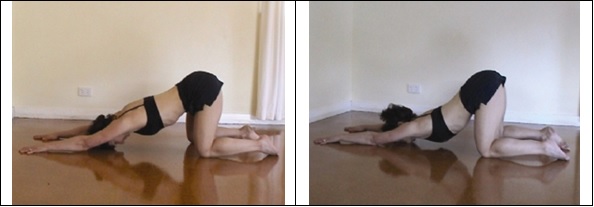
- Straighten both of your elbows.
- Take another deep breath in.
- Exhale and bring both shoulders and both sides of upper thoracic spine and rib cage towards the floor.
- Continue to bring your chest further towards the floor with each exhalation.
- Determine where your thoracic is most restricted and focus on this area.
Introduce sidebending by sideshifting your upper thoracic spine to one side and then repeat the extension and sidebending on the opposite side.

2.5b Upper Dog extension stretch standing
Starting position: Standing facing a wall with your feet apart. Place your palms on the wall above your head shoulder distance apart. Take a step back with one foot and flex your knees slightly. Extend your elbows until your arms are straight. Place your forehead on the wall and extend your thoracic spine.

Technique: See Part A.

2.5c Latissimus dorsi stretch kneeling
Starting position: Kneeling on the floor facing a stool. Bring your elbows, forearms and palms together. This will externally rotate your arms and separate your shoulder blades. Lean forwards and place your elbows on the stool. Your knees and feet are slightly apart for better balance.
Technique: See Part A.

Direction and range of movement
This is primarily a stretch involving extension of the thoracic spine and hyperflexion of the shoulders. Sidebending of the thoracic spine can also be introduced into the technique.
Most of the thoracic spine is in the naturally flexed position, which is known as a thoracic kyphosis. Some areas of the thoracic spine deviate from this overall flexed position and much variation exists between individuals.
In the thoracic spine (T1 to T12) total extension is about 25 degrees. Much of the extension is usually between T10 and T12 and significant extension may be found around T4 or over several vertebrae between T3 and T6.

Due to the shape of the vertebra and the discs in the spine there will be more extension in some part of the spine and less in others. In general areas of the spine that are in an extended position (lordosis) will have more extension and less flexion, and areas of the spine that are in a flexed position (kyphosis) will have more flexion and less extension. In this stretch it is important to identify the areas of flexion and extension, so as to extend the flexed areas and avoid further extending areas that are already extended.
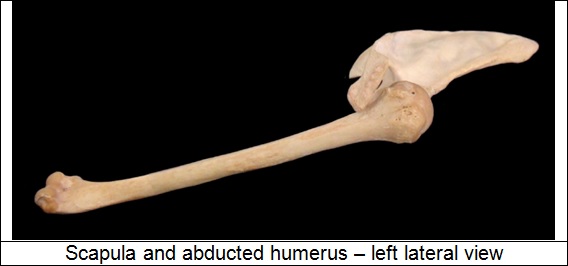
Shoulder flexion is 180 degrees but will be greater in hypermobile individuals. Shoulder flexion is movement of the arm forward and upwards to the vertical position. It is a combination of glenohumeral joint and scapulothoracic joint movement. Movement of the humerus is checked when the greater tuberosity comes in contact with the acromion process and area above the glenoid fossa. Movement continues as scapular protraction and upward rotation.
Target tissues
The upper dog stretches the muscles, fascia and ligaments attached to the clavicle, sternum, anterior ribs and the humerus.

This is mainly a stretch for latissimus dorsi, teres major, pectoralis minor and the sternocostal fibres of pectoralis major. To a lesser extent this is also a stretch for posterior deltoid, the long head of triceps and the most anterior intercostal muscles.
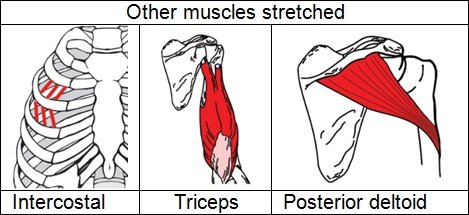
Stretching occurs as a result of muscle contraction from serratus anterior, lower trapezius, erector spinae and anterior deltoid and the assistance of gravity.

This technique should be done with the forehead resting on the floor. If this is uncomfortable because it puts pressure on your nose, then try resting your forehead on a small pillow. Do not allow your head to be pushed backwards and the weight of your body to be taken through your chin and strain muscles or ligament in the suboccipital spine. Keep the head and neck as close as possible to a neutral position – do not allow hyperextension.
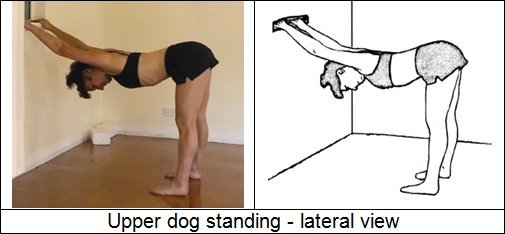
Determine where your thoracic spine is most restricted and focus on this area. Vary how far the arms are apart by varying the placement of the hand. They can be close to the side of the head or wider apart. This will change, very slightly, which fibres of the muscle are stretched. This can be done as an active, passive or post-isometric technique. During the passive stretch relax and use the weight of the upper body to assistance with this stretch.
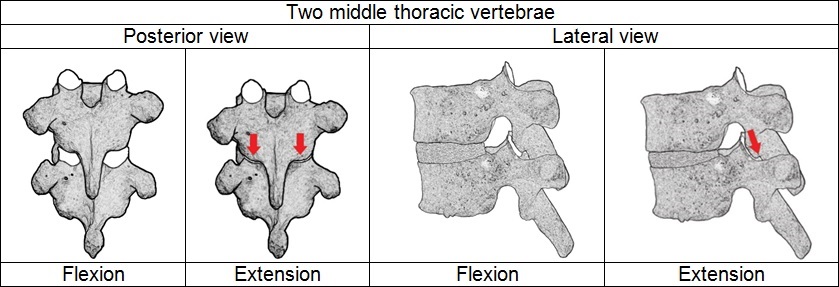
Other factors
The shape of the spine differs between individuals and this should influence the way different individuals do the upper dog.
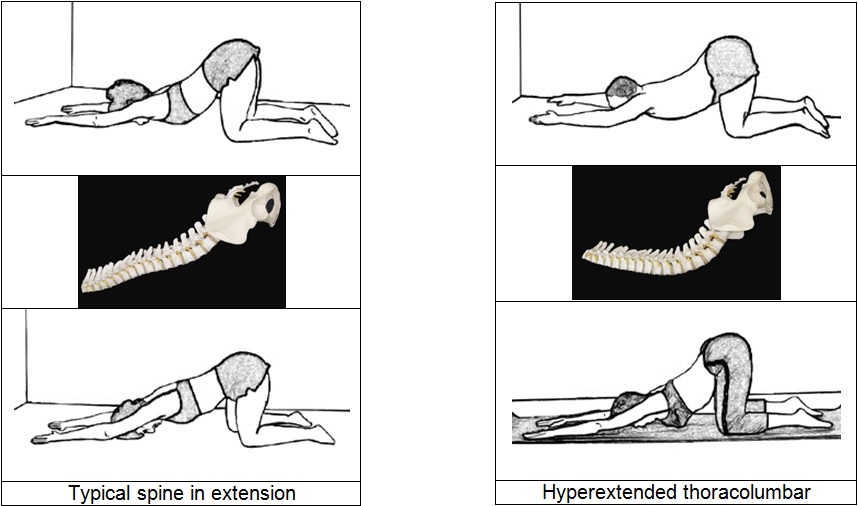
This technique has benefits for individuals with slouched and round shoulders, who also may have fixed flexed areas within the thoracic spine, an increased kyphosis, a dowager hump, or a reverse lordosis in the thoracolumbar or lumbar region. Postural changes are associated with muscles in front of the shoulders becoming short, thus this technique counters the shortness well.
Safety
Care should be taken not to over extend the thoracolumbar spine. If the area is hypermobile then pressure on the joints may cause ligaments or muscles to be over stretched which may result in strain and injury.
The rotator cuff tendons are vulnerable to tearing in individuals with an exaggerated kyphosis, short pectoralis muscles, and inflexibility within the thoracic spine, ribs and shoulders.
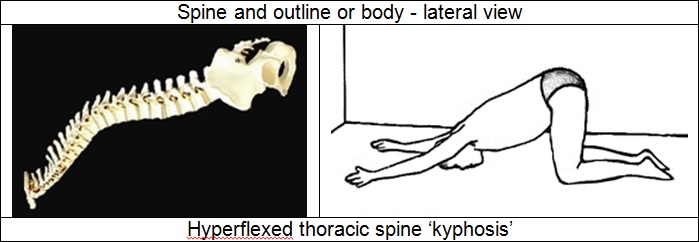
If you fit this profile then it is advisable that you stretch each shoulder separately before attempting to stretch both shoulders. Insufficient warming up prior to stretching, or moving into the stretch too quickly may result in a rotator cuff injury.
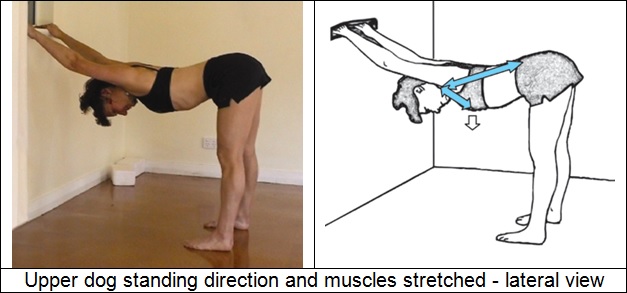
Do not do this stretch if you have a pre-existing bursitis or rotator cuff tear. Fix the problem with treatment (manual therapy or surgery) and build up the structural integrity of the cuff tendon with strengthening exercises before attempting the upper dog stretch. Always take your time to warm up your body before doing this stretch.

Vulnerable areas
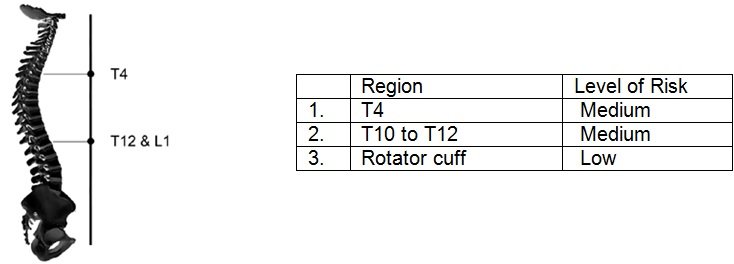
Key
